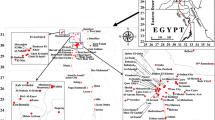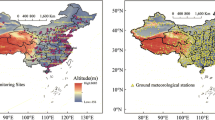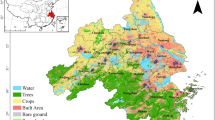Abstract
The accurate and informative space-time mapping of air pollutants is a crucial component of many human exposure studies. In the present work, space-time maps of daily distributions of PM2.5 and NO2 concentrations were generated in the severely polluted northern China region using the Bayesian maximum entropy (BME) method. This method can incorporate hard PM2.5 and NO2 data (obtained at ground-level monitoring sites), and various kinds of soft (uncertain) data, including satellite data processed in terms of machine learning techniques, meteorological variables, and geographical predictors. The BME maps of space-time PM2.5 and NO2 concentrations over northern China generated during the winter season (when severe haze episodes occur frequently) were realistic and informative. As regards their numerical accuracy, for the space-time PM2.5 estimates, the tenfold cross-validation R 2 and the RMSE were, respectively, 0.86 and 14.37 μg/m3; for the space-time NO2 estimates, the R 2 and RMSE values were, respectively, 0.85 and 6.93 μg/m3. Lastly, it was shown that the BME method performed better than the mainstream spatiotemporal ordinary kriging technique in terms of the higher R 2 values of both the predicted PM2.5 and NO2 concentration maps.








Similar content being viewed by others
References
Apte JS, Marshall JD, Cohen AJ, Brauer M (2015) Addressing global mortality from ambient PM2.5. Environ Sci Technol 49:8057–8066
Bechle MJ, Millet DB, Marshall JD (2015) National spatiotemporal exposure surface for NO2: monthly scaling of a satellite-derived land-use regression, 2000–2010. Environ Sci Technol 49:12297–12305
Center for International Earth Science Information Network - CIESIN - Columbia University (2015) Gridded population of the world, version 4 (gpwv4): population count. NASA Socioeconomic Data and Applications Center (SEDAC), Palisades
Christakos G (1990) A Bayesian maximum-entropy view to the spatial estimation problem. Math Geol 22:763–777
Christakos G (1992) Random field models in earth sciences. Academic Press, San Diego. New Edition (2005), Dover Publ. Inc., Mineola, NY
Christakos G (2000) Modern spatiotemporal geostatistics. Oxford University Press, New York
Christakos G (2017) Spatiotemporal random fields: theory and applications. Elsevier, Cambridge
Christakos G, Hristopulos DT (1996) Characterization of atmospheric pollution using stochastic indicators. Atmos Environ 30(22):3811–3823
Christakos G, Hristopulos DT (1998) Spatiotemporal environmental health modelling: a tractatus stochasticus. Kluwer Academic Publ, Boston
Christakos G, Serre ML (2000) BME analysis of spatiotemporal particulate matter distributions in North Carolina. Atmos Environ 34(20):3393–3406
Christakos G, Serre ML, Kovitz J (2001) BME representation of particulate matter distributions in the state of California on the basis of uncertain measurements. J Geophys Res 106(D9):9717–9731
Di Q, Kloog I, Koutrakis P, Lyapustin A, Wang YJ, Schwartz J (2016) Assessing PM2.5 exposures with high spatiotemporal resolution across the continental united states. Environ Sci Technol 50:4712–4721
Du Y, Li T (2016) Assessment of health-based economic costs linked to fine particulate (PM2.5) pollution: a case study of haze during January 2013 in Beijing, China. Air Qual Atmos Health 9(4):439–445
Engel-Cox JA, Holloman CH, Coutant BW, Hoff RM (2004) Qualitative and quantitative evaluation of MODIS satellite sensor data for regional and urban scale air quality. Atmos Environ 38:2495–2509
He J, Kolovos A (2017) Bayesian maximum entropy approach and its applications: a review. Stoch Env Res Risk A 6:1–19
Hu X, Belle JH, Xia M, Wildani A, Waller L, Strickland M, Liu Y (2017) Estimating PM2.5 concentration in the conterminous United States using the random forest approach. Environ Sci Technol 51(12):6936–6944
Kenagy HS, Lin C, Wu H, Heal MR (2016) Greater nitrogen dioxide concentrations at child versus adult breathing heights close to urban main road kerbside. Air Qual Atmos Health 9(6):1–7
Kloog I, Nordio F, Coull BA, Schwartz J (2012) Incoporating local land use regression and satellite aerosol optical depth in a hybrid model of spatiotemporal PM2.5 exposures in the mid-atlantic states. Environ Sci Technol 46:11913–11921
Kuhn M (2008) Building predictive models in r using the caret package. J Stat Softw 28:1–26
Lee HJ, Koutrakis P (2014) Daily ambient NO2 concentration predictions using satellite ozone monitoring instrument NO2 data and land use regression. Environ Sci Technol 48:2305–2311
Li TW, Shen HF, Zeng C, Yuan QQ, Zhang LP (2017) Point-surface fusion of station measurements and satellite observations for mapping PM2.5 distribution in china: methods and assessment. Atmos Environ 152:477–489
Liu Y, Franklin M, Kahn R, Koutrakis P (2007) Using aerosol optical thickness to predict ground-level PM2.5 Concentrations in the st. Louis area: a comparison between misr and modis. Remote Sens Environ 107:33–44
Liu Y, Paciorek CJ, Koutrakis P (2009) Estimating regional spatial and temporal variability of PM2.5 concentrations using satellite data, meteorology, and land use information. Environ Health Perspect 117:886–892
Ma ZW, Hu XF, Huang L, Bi J, Liu Y (2014) Estimating ground-level PM2.5 In china using satellite remote sensing. Environ Sci Technol 48:7436–7444
Qin SS, Liu F, Wang C, Song YL, Qu JS (2015) Spatial-temporal analysis and projection of extreme particulate matter (PM10 and PM2.5) levels using association rules: a case study of the Jingjinji region, China. Atmos Environ 120:339–350
Reid CE, Jerrett M, Petersen ML, Pfister GG, Morefield PE, Tager IB, Raffuse SM, Balmes JR (2015) Spatiotemporal prediction of fine particulate matter during the 2008 northern California wildfires using machine learning. Environ Sci Technol 49:3887–3896
Remer LA, Kaufman YJ, Tanré D, Mattoo S, Chu DA, Martins JV et al (2005) The modis aerosol algorithm, products, and validation. J Atmos Sci 62(4):947–973
Song WZ, Jia HF, Huang JF, Zhang YY (2014) A satellite-based geographically weighted regression model for regional PM2.5 estimation over the pearl river delta region in china. Remote Sens Environ 154:1–7
Song CB, He JJ, Wu L, Jin TS, Chen X, Li RP, Ren PP, Zhang L, Mao HJ (2017) Health burden attributable to ambient PM2.5 in China. Environ Pollut 223:575–586
Weichenthal SA, Godri-Pollitt K, Villeneuve PJ (2013) PM2.5, oxidant defence and cardiorespiratory health: a review. Environ Health 12(1):1–8
Wu J, Yao F, Li W, Si M (2016) Viirs-based remote sensing estimation of ground-level pm2.5 concentrations in Beijing–Tianjin–Hebei: a spatiotemporal statistical model. Remote Sens Environ 184:316–328
Xie YY, Wang YX, Zhang K, Dong WH, Lv BL, Bai YQ (2015) Daily estimation of ground-level pm2.5 concentrations over Beijing using 3 km resolution MODIS AOD. Environ Sci Technol 49:12280–12288
Yang Y, Christakos G (2015) Spatiotemporal characterization of ambient PM2.5 concentrations in Shandong province (China). Environ Sci Technol 49:13431–13438
Yu HL, Kolovos A, Christakos G, Chen JC, Warmerdam S, Dev B (2007) Interactive spatiotemporal modelling of health systems: the SEKS-GUI framework. Stoch Env Res Risk A 21:555–572
Yu H-L, Chen J-C, Christakos G, Jerrett M (2009) BME estimation of residential exposure to ambient PM10 and ozone at multiple time-scales. Environ Health Perspect 117:537–544
Zhan Y, Luo YZ, Deng XF, Chen HJ, Grieneisen ML, Shen XY, Zhu LZ, Zhang MH (2017) Spatiotemporal prediction of continuous daily PM2.5 concentrations across china using a spatially explicit machine learning algorithm. Atmos Environ 155:129–139
Zheng YX, Zhang Q, Liu Y, Geng GN, He KB (2016) Estimating ground-level PM2.5 concentrations over three megalopolises in china using satellite-derived aerosol optical depth measurements. Atmos Environ 124:232–242
Acknowledgements
The authors acknowledge with appreciation the valuable comments made by the three referees. This research was supported by a grant from the National Science Foundation of China (Grant No. NSFC 41671399).
Author information
Authors and Affiliations
Corresponding author
Electronic supplementary material
ESM 1
(DOC 2326 kb)
Rights and permissions
About this article
Cite this article
Jiang, Q., Christakos, G. Space-time mapping of ground-level PM2.5 and NO2 concentrations in heavily polluted northern China during winter using the Bayesian maximum entropy technique with satellite data. Air Qual Atmos Health 11, 23–33 (2018). https://doi.org/10.1007/s11869-017-0514-8
Received:
Accepted:
Published:
Issue Date:
DOI: https://doi.org/10.1007/s11869-017-0514-8




